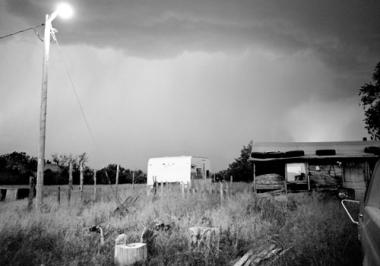Most Mondays, Greenfield resident Leah Dyjak packs up her photography equipment and heads north to Retreat Healthcare, often dubbed the Brattleboro Retreat by locals. The inpatient facilility, nestled amid a cluster of rolling hills, is a nationally renowned mental health and addiction treatment center specializing in therapeutic and behavioral healthcare.
There she greets the teenage girls who have opted to take part in her photography workshop that day. Then the group discusses what kind of pictures they want to make—often self-portraits. Because Dyjak uses large-format Polaroid cameras, the girls can instantly see the fruits of their labor, which helps them avoid frustration and impatience.
"I never know how many girls will be there or what kind of mood they're in," said Dyjak in a recent interview with the Advocate. "Every week, to myself, I'm like, 'Hey, let's make pictures and not do drugs.' I think [the class] has had a positive effect. In order to take part in it they have to not be in trouble, and I think they look forward to me coming. I'm a friend at this point."
Dyjak became affiliated with the Retreat through In-Sight Photography, where she is an assistant program director. Also based in Brattleboro, In-Sight offers programs for Windham County youth, ages 11-18, regardless of their ability to pay, teaching them the visual language of photography.
"I have the best job in the world," said Dyjak of In-Sight. "I absolutely love it… It literally gives me the tools to do what I want to do."
Through In-Sight, Dyjak also had the opportunity to participate in Exposures, a cross-cultural youth exchange in which In-Sight directors and students travel to the Pine Ridge Indian Reservation in North Dakota, the poorest reservation in the country. Using photography as a medium, the New England students interacted with children and adults of the Oglala Lakota Nation. This year's Exposures program is slated to enable Oglala children to travel to the Pioneer Valley for photography workshops.
Dyjak's career as a photographer began when she was working as a lifeguard at a Six Flags water park. She woke up one morning and there was a single thought in her head: she was going to be a photographer.
"I went out that same day and bought a $500 Minolta 430 SI at Ritz Camera in the Holyoke Mall."
After high school, Dyjak attended Greenfield Community College, then later MassArt in Boston, where she received her BFA in photography.
However, Dyjak believes it's her experience teaching photography and not her education that has buoyed her confidence as a photographer and enabled her to take the next step in her career—mounting a solo show.
"I lacked confidence that it would be something great," said Dyjak. "Teaching has given me the confidence I needed."
Thin Lines, a group of 13 black-and-white large-format photographs, is currently on display at the Vermont Center for Photography.
Some of the photographs were taken during Dyjak's stay in North Dakota; the others were taken in the Pioneer Valley. All of them have an ethereal quality, and capture the ghostlike beauty of decay.
"I photograph things that have a presence that I can feel but can't see& things that had a purpose once but now are eroding as time hits them," said Dyjak.
The first photographs in the series were taken in 2005 when Dyjak began exploring abandoned, dilapidated factories in Easthampton. She took pictures of buckling floors, discarded barrels and half-hung tarps, all juxtaposed with some source of light or white element—perhaps a small piece of white plastic, sunlight streaming through a dingy window, or a foggy white haze hovering over a factory floor.
"When I photograph, I try to find something hopeful, some light source, because the things I'm looking at are usually pretty desolate," said Dyjak.
After reflecting on the "white" in her photographs, Dyjak found a sense of peace she had been seeking, as well as inspiration for her current series. Dyjak had been attempting to process her grief over the illness and eventual death of a close friend.
"I had a friend sick with cancer on life support for months," said Dyjak. "Every day I'd visit him, see him breathing with a machine. He wasn't at all alive, but still on Earth somehow. After I found the white things, I found peace in that space and things began to make sense."
Dyjak then went on to photograph landscapes, some with deteriorating man-made structures like fences, shacks or foundations, and some with barren, rotting trees or desolate prairie—again, all juxtaposed with some source of light or white element.
All the photographs in Thin Lines try to capture the transitional space between worlds. Dyjak emphasizes the metaphysical aspect of the images by printing them on photo rag with rough, jagged white edges—as if she'd torn the material haphazardly from a notebook.
"I don't want the edges to be refined," said Dyjak. "I want [the images] to appear as if they're floating in space."
Thin Lines is on display through May 31 at the Vermont Center for Photography, 44 Flat St., Brattleboro, (802) 251-6051, www.leahdyjak.com.



